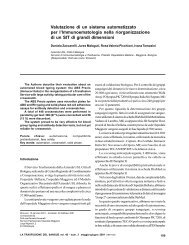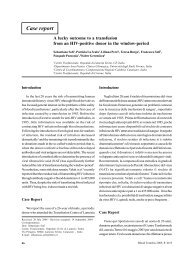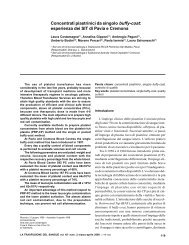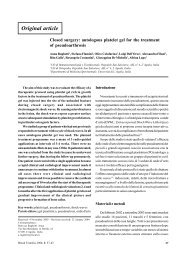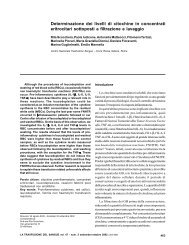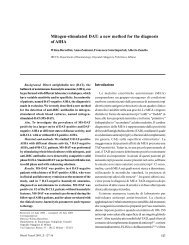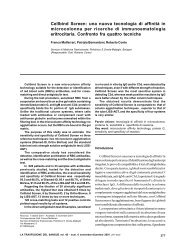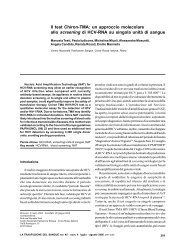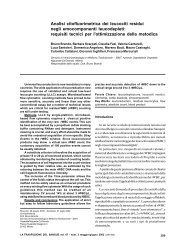Mathematics and transfusion medicine - Blood Transfusion
Mathematics and transfusion medicine - Blood Transfusion
Mathematics and transfusion medicine - Blood Transfusion
Create successful ePaper yourself
Turn your PDF publications into a flip-book with our unique Google optimized e-Paper software.
Flegel W Athis would be likely to result in Rhesus haemolytic diseaseof the newborn.The function of Rhesus proteinsMost blood group proteins have a known function.While purifying human Rhesus proteins, Americanphysician Peter Agre discovered a water transporterprotein 28 . This discovery earned him the 2003 Nobel Prizefor Chemistry. Despite intensive efforts, however, nofunction has been found for the RhD <strong>and</strong> RhCE proteins.Although the Rhesus associated antigen (RhAG), a Rhesushomologue contained in erythrocytes, can transportammonium ions 29 , the Rhesus proteins themselves couldnot be shown to have any such function. One possiblefunction under investigation involves the exchange of CO 2<strong>and</strong> even O 2. Other information on the RH alleles will onlybe gained from the everyday clinical application of geneticdiagnostics, which could thus contribute to identifyingtheir function.From the perspective of basic research, where<strong>transfusion</strong> <strong>medicine</strong> will continue to make a contribution,scientific work on Rhesus 30 <strong>and</strong> other blood groups hasbeen quite productive, <strong>and</strong> is anything but finished.OutlookGenetic diagnosis has been used for blood group typingin clinical <strong>transfusion</strong> <strong>medicine</strong> ever since 2000 31,32 . Asantenatal care has shown, genetic blood group typing hasled to a better quality of care, by helping to avoid potentialside effects <strong>and</strong> reducing costs. This is a rare combination,<strong>and</strong> justifies the extra costs involved in optimizing care viathe use of genetic diagnostic techniques. As well asimproving patient care, these methods can fuel thedevelopment of new methods 14 , which will also be used forhealth care outside of Germany. European departments of<strong>transfusion</strong> <strong>medicine</strong> are leading the field in molecular bloodgroup diagnostics <strong>and</strong> applications, <strong>and</strong> will continue tocontribute to improving patient care.Common Genome Variability Terms 4,6SNP (single nucleotide polymorphism)Point mutation. Variability in a nucleotide sequence dueto change of a single nucleotide.AlleleThe expression of a coding or non coding nucleotidesequence (the exon resp. intron of a gene) with two ormore variants, often differing by only a point mutation.GenotypeA pair of alleles or variants of a nucleotide sequenceoccurring at homologous sites on paired chromosomes.HaplotypeA combination of alleles or variants of a nucleotidesequence located close together on the samechromosome, <strong>and</strong> usually inherited together.Missense mutationAmino acid substitution in a protein caused by a pointmutation. It can alter the function or antigenicity of aprotein.Nonsense mutationA stop codon caused by a point mutation whichprematurely stops synthesis of the amino acid chain,leading to loss of protein function of its expression.Silent mutationA point mutation which does not change the aminoacid at the site. Although the protein is unchanged, itstill can be associated with a clinically relevantphenotype <strong>and</strong> be used diagnostically.Frame shift mutationThe loss or insertion of one or two nucleotides whichshifts the reading frame <strong>and</strong> prematurely stops proteinsynthesis (or extends it in some rare cases), resulting inloss of protein function or expression.Splice site mutationA point mutation at a splice site (the exon-intronjunction), causing faulty splicing of messenger RNA(mRNA) <strong>and</strong> skipping an exon, thus changing the aminoacid sequence. Leads to loss of protein function orexpression.Gene conversionThe non-reciprocal exchange between two or morehomologous genes, whereby a certain nucleotidesequence on a gene is substituted by a sequence onanother gene, which is located on the same chromosome(conversion in cis).AcknowledgementsThis article is published by the courtesy of ChristopherBaethge, M.D., Editor in Chief of the journal DeutschesÄrzteblatt. This English translation was provided by thejournal Deutsches Ärzteblatt.Key Word: Rhesus, blood group, molecular diagnostic,<strong>transfusion</strong>, pregnancy.References1) Flegel WA, Wagner FF. Blutgruppen: Alloantigene aufErythrozyten. In: Mueller-Eckhardt C, Kiefel V, eds.:<strong>Transfusion</strong>smedizin. Berlin, Berlin Springer; 2003: p. 145-85.2) Howard H, Martlew V, McFadyen I, et al. Consequences for56<strong>Blood</strong> Transfus 2007; 5: 50-57050-57_flegel.p65 5605/07/2007, 10.34



